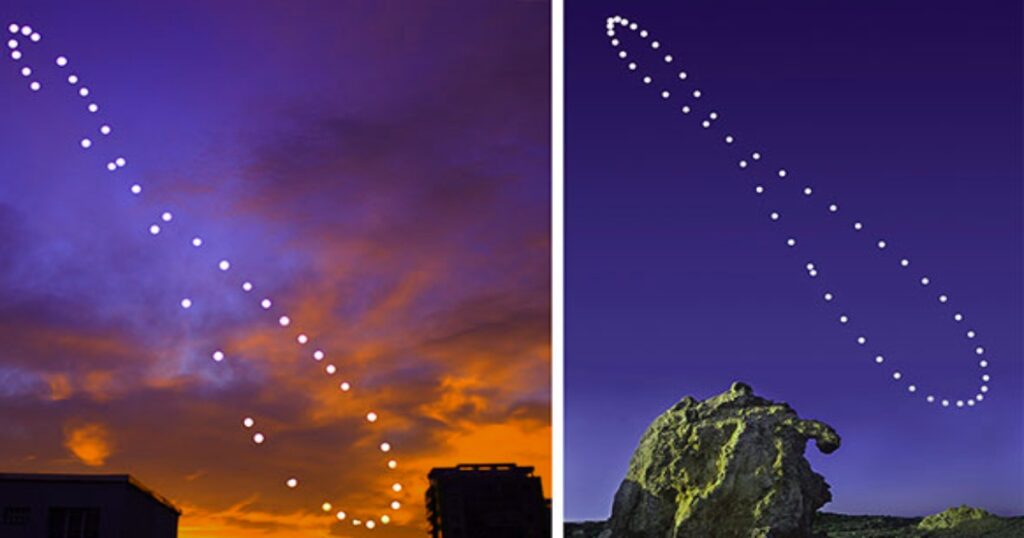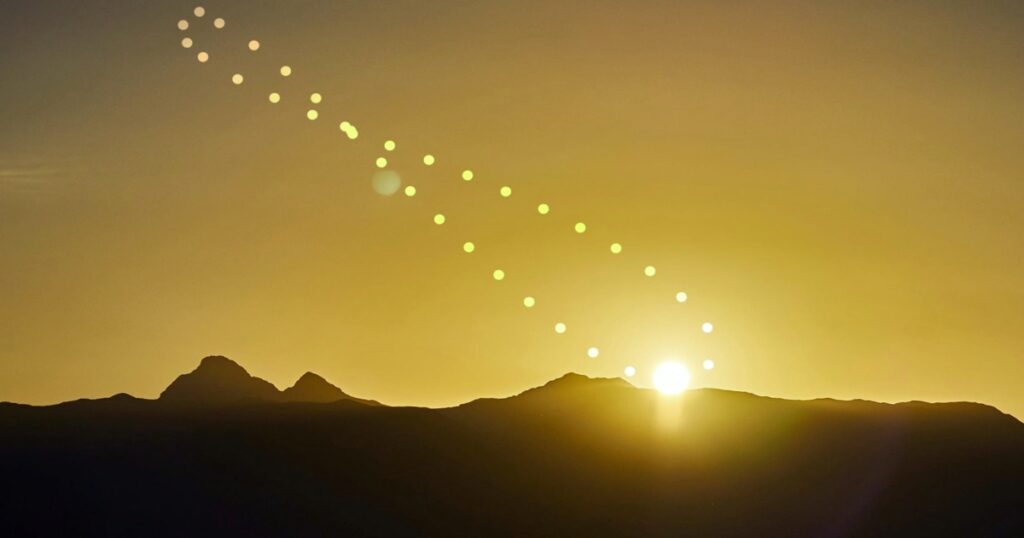Solar Analemma and Lunar Analemma are the looping paths traced by the position of the Sun in the sky throughout the year, caused by the Earth‘s tilt and orbit, and traced by the position of the Moon in the sky over a lunar month, due to the Moon’s tilted orbit and varying speed.

What is the meaning of Solar Analemma?
A solar analemma is a fascinating phenomenon that reveals the Sun’s apparent movement in the sky throughout the year (365 days).

Concept of Solar Analemma:
Imagine taking a picture of the Sun from the same spot on Earth every day for a year, always at the same time. If you were to plot the position of the Sun in each picture, you’d see it forms a closed curve resembling a slightly elongated figure eight. This curve is called the solar analemma.
Cause of Solar Analemma:
The Earth’s axial tilt (23.4 degrees) and its elliptical orbit around the Sun are responsible for the analemma’s shape. The tilt creates seasonal variation in the Sun’s path across the sky, while the elliptical orbit causes slight variations in the Sun’s apparent distance throughout the year.
Appearance of Solar Analemma:
The analemma is typically wider in one loop than the other. The wider loop corresponds to the period when the Earth is closest to the Sun (perihelion) and moves faster in its orbit. The narrower loop occurs when the Earth is farthest from the Sun (aphelion) and moves slower.
Location of Solar Analemma:
The analemma isn’t visible in the sky itself. It’s a concept created by plotting the Sun’s positions over time. However, terrestrial globes often depict the analemma as a way to visualize the Sun’s apparent path.
Overall, the solar analemma is a beautiful illustration of how the Earth’s motion and orientation combine to influence our perception of the Sun’s movement in the sky.
What is the meaning of Lunar Analemma?
A lunar analemma is a concept similar to the solar analemma, but instead of tracking the Sun’s position throughout the year, it tracks the Moon’s position over a lunar month (approximately 29.5 days).

Concept of Lunar Analemma:
Imagine taking a picture of the Moon from the same spot on Earth every night, always at the same time (accounting for the Moon’s rising and setting times). If you were to plot the position of the Moon in each picture over a lunar month, you’d see it forms a closed, figure-eight-shaped curve, similar to the solar analemma but much smaller.
Cause of Lunar Analemma:
The lunar analemma is primarily caused by the Moon’s tilted orbit around Earth (about 5 degrees) and the variation in the Moon’s orbital speed throughout its monthly journey. This variation occurs because the Moon’s orbit is not perfectly circular.
Appearance of Lunar Analemma:
The lunar analemma is also wider in one loop than the other. This difference corresponds to when the Moon is closest to Earth (perigee) and farthest from Earth (apogee) in its orbit. The wider loop occurs during perigee when the Moon appears slightly larger and brighter.
Observation of Lunar Analemma:
Like the solar analemma, the lunar analemma isn’t directly visible in the night sky. It’s a concept created by plotting the Moon’s positions over time. However, with clear skies and dedicated photography, you can capture the Moon’s varying positions over a lunar month and create a composite image showcasing the lunar analemma.
Overall, the lunar analemma provides a fascinating perspective on the Moon’s complex dance around Earth, highlighting the subtle variations in its position and appearance throughout the lunar cycle.
Difference between Solar Analemma and Lunar Analemma:
Timescale: Solar analemma takes a year, while the lunar analemma takes a lunar month (significantly shorter).
Cause: The solar analemma is caused by the Earth’s tilt and elliptical orbit, while the lunar analemma is caused by the Moon’s tilted orbit and varying orbital speed.
Visibility: Both are not directly visible, but the lunar analemma requires a shorter observation period.
Solar Analemma Vs. Lunar Analemma
| Feature | Solar Analemma | Lunar Analemma |
|---|---|---|
| Observed Object | Sun | Moon |
| Timescale | 1 year | ~29.5 days (Lunar Month) |
| Cause | Earth’s axial tilt and elliptical orbit | Moon’s tilted orbit and varying orbital speed |
| Shape | Figure-eight, much wider in one loop | Figure-eight, wider in one loop |
| Wider Loop | Perihelion (Earth closest to Sun) | Perigee (Moon closest to Earth) |
| Narrower Loop | Aphelion (Earth farthest from Sun) | Apogee (Moon farthest from Earth) |
| Visibility | Not directly visible, plotted from daily observations | Not directly visible, plotted from nightly observations (over a lunar month) |
Conclusion:
The solar and lunar analemmas, while unseen directly, are beautiful illustrations of celestial mechanics. Together, they remind us of the fascinating interplay between gravity, orbital paths, and our perspective as Earthlings, etching graceful patterns onto the canvas of our sky.